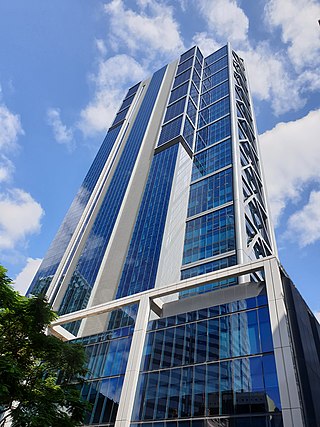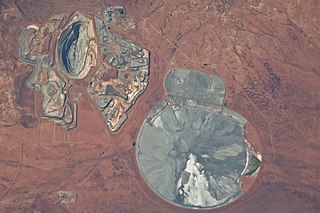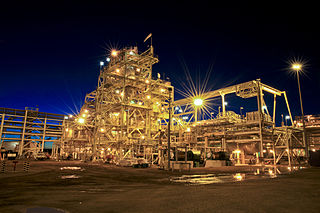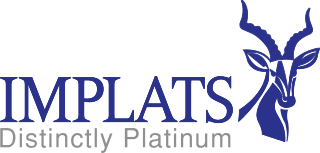Related Research Articles

BHP Group Limited, also known as Broken Hill Proprietary Company and formerly as BHP Billiton is an Australian multinational mining and metals public company that was founded in August 1885 and is headquartered in Melbourne.

Vale Canada Limited is a wholly owned subsidiary of the Brazilian mining company Vale. Vale's nickel mining and metals division is headquartered in Toronto, Ontario, Canada. It produces nickel, copper, cobalt, platinum, rhodium, ruthenium, iridium, gold, and silver. Prior to being purchased by CVRD in 2006, Inco was the world's second largest producer of nickel, and the third largest mining company outside South Africa and Russia of platinum group metals. It was also a charter member of the 30-stock Dow Jones Industrial Average formed on October 1, 1928.

WMC Resources Limited was an Australian diversified mining company.
Anglo American plc is a British multinational mining company with headquarters in London, England. It is the world's largest producer of platinum, with around 40% of world output, as well as being a major producer of diamonds, copper, nickel, iron ore, polyhalite and steelmaking coal. The company has operations in Africa, Asia, Australia, Europe, North America and South America.
Lonmin plc, formerly Lonrho plc, was a British producer of platinum group metals operating in the Bushveld Complex of South Africa. It was listed on the London Stock Exchange. Its registered office was in London, and its operational headquarters were in Johannesburg, South Africa.

The Potash Corporation of Saskatchewan, also known as PotashCorp, was a company based in Saskatoon, Saskatchewan. The company merged with Calgary-based Agrium to form Nutrien, in a transaction that closed on January 1, 2018.

Norilsk Nickel, or Nornickel, is a Russian nickel and palladium mining and smelting company. Its largest operations are located in the Norilsk–Talnakh area near the Yenisei River in the north of Siberia. It also has holdings in Nikel, Zapolyarny, and Monchegorsk on the Kola Peninsula, in Harjavalta in western Finland, and in South Africa.
Paladin Energy Ltd is a Western Australian based uranium production company.

Mount Keith Mine is an open pit nickel mine in Western Australia. It is operated by BHP. The site's closest landmark is the town of Wiluna, 85 km (53 mi) to the north.
Lundin Mining Corporation is a Canadian company that owns and operates mines in Sweden, United States, Chile, Portugal and Brazil that produce base metals such as copper, zinc, and nickel. Headquartered in Toronto, the company was founded by Adolf Lundin and operated by Lukas Lundin. While it was incorporated to pursue an interest in a diamond mine in Brazil, the company re-structured and raised funds to develop the Storliden mine in Sweden. It purchased the Swedish Zinkgruvan Mine from Rio Tinto and then merged with Arcon International Resources for its Galmoy Mine in Ireland and with Eurozinc for its Neves-Corvo mine in Portugal. The company subsequently purchased and operated the Eagle mine, Candelaria mine, and Chapada mine.
The mineral industry of Russia is one of the world's leading mineral industries and accounts for a large percentage of the Commonwealth of Independent States' production of a range of mineral products, including metals, industrial minerals, and mineral fuels. In 2005, Russia ranked among the leading world producers or was a significant producer of a vast range of mineral commodities, including aluminum, arsenic, cement, copper, magnesium compounds and metals, nitrogen, palladium, silicon, nickel and vanadium.
The Quivira Mining Corporation was a uranium mining company owned by Kerr-McGee. It was established in 1983.

The Ravensthorpe Nickel Mine is a nickel mine and hydrometallurgical processing plant located at Bandalup Hill, 35 km (22 mi) east of Ravensthorpe, Western Australia.

Impala Platinum Holdings Limited or Implats is a South African holding company that owns several companies which operate mines that produce platinum and platinum group metals, as well as nickel, copper and cobalt. Its most significant mine is the Impala mine in the North West province of South Africa. The company also owns or has interest in the Two Rivers mine and the Marula mine in the South Africa Bushveld Igneous Complex and the Mimosa mine and Zimplats in Zimbabwe, as well as the Impala Refining Services which smelts and refines metals for other companies. In December 2019, Impala Canada was formed, owned by the holding company, out of the acquisition of North American Palladium and its mine in Ontario, Canada.
Union Corporation Limited was a South African mining house. It was founded as the A Goerz & Co Ltd in the late 1890's as a gold mining company. After World War One, it was renamed the Union Corporation. In 1980 it was merged into the General Mining and Finance Corporation later called Gencor.

Nickel mining in Western Australia has been an industry that has had many fluctuations of fortune in its history. Large fluctuations in the world nickel price have seen mines close and reopen on several occasions.
Sir Michael Lawrence Davis is a South African former businessman, was the chief executive (CEO) of Xstrata plc, an Anglo-Swiss multinational mining company, until its merger with Glencore in 2013, and former chief executive and treasurer of the Conservative Party. After leaving Xstrata, he formed the mining venture X2 Resources. He was the Chairman of the British Conservative Party until he exited that post in July 2019 along with PM Theresa May.

The Olympic Dam mine is a large poly-metallic underground mine located in South Australia, 550 km (340 mi) NNW of Adelaide. It is the fourth largest copper deposit and the largest known single deposit of uranium in the world. Copper is the largest contributor to total revenue, accounting for approximately 70% of the mine's revenue, with the remaining 25% from uranium, and around 5% from silver and gold. BHP has owned and operated the mine since 2005. The mine was previously owned by Western Mining Corporation. Since the 1970s environmentalists, traditional owners and others have campaigned against the mine, largely on the basis of its contribution to the nuclear cycle and its use of underground water.

South32 Limited is a mining and metals company headquartered in Perth, Western Australia. It was spun out of BHP Billiton on 18 May 2015. It is listed on the Australian Securities Exchange with secondary listings on the Johannesburg and London Stock Exchanges.
Federale Mynbou (FedMyn) was a South African mining holding company created in 1953 as a means for Afrikaner business capital to obtain some control of the country's mining industry, dominated at the time by English South African mining companies. Initially a mining company, it became a holding company of the General Mining and Finance Corporation and the United Corporation that eventually became Gencor. Federale Mynbou itself was partially own at that time by Sanlam and the Rembrandt Group.
References
- 1 2 3 4 5 Musiker, Naomi; Musiker, Reuben (2000). A Concise Historical Dictionary of Greater Johannesburg. Cape Town: Francolin. ISBN 1868590712.
- ↑ Ball, James (23 August 2016). "End of an era for historic mining firm". The Heritage Port. Retrieved 13 March 2018.
- 1 2 3 4 5 International directory of company histories. Vol. 22. Detroit, Mich.: St. James Press. 1998. ISBN 978-1-55862-663-8.
- ↑ Gold Fields: a centenary portrait. London Weidenfeld & Nicolson. 1987. ISBN 978-0-297-78967-3.
- 1 2 3 4 Pangalos, Philip (12 May 1993). "Gencor eyes Shell metal businesses". The Times .
- ↑ "Gencor may unbundle". The Times. 29 April 1993.
- ↑ "Shell Unit Sells Assets To Gencor". New York Times . 27 July 1994. Retrieved 18 April 2011.
- 1 2 Mortished, Carl (27 July 1994). "Gencor acquires Billiton metal assets from Shell". The Times.
- ↑ Bennett, Neil (21 June 1995). "Lonrho seeks gold in platinum merger". The Times.
- ↑ Cunningham, Sarah (1 December 1995). "Lonrho to merge platinum". The Times.
- ↑ Ashworth, Jon (25 April 1996). "EU blocks Lonrho-Gencor link over platinum price-fixing fear". The Times.
- ↑ "Lonrho ends Gencor bid". Times. 15 August 1996.
- 1 2 3 4 Mortished, Carl (19 June 1997). "Biliiton intends to raise $1bn after Gencor demerger". The Times. No. 65920.
- 1 2 Dunne, Helen (11 October 1997). "Merger creates gold giant". The Daily Telegraph .
- ↑ Gold Fields "Our History". Retrieved February 14, 2018.